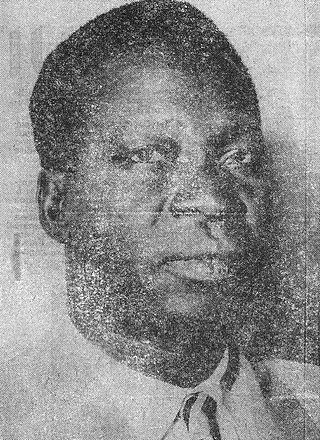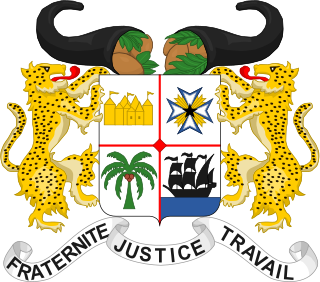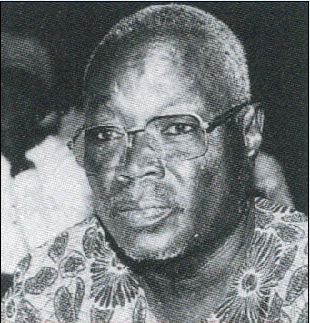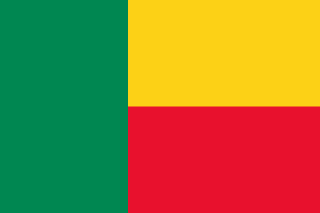
Sourou-Migan Marcellin Joseph Apithy was a Beninese political figure most active when his country was known as Dahomey. He arose on a political scene where one's power was dictated by what region in Dahomey one lived in.

Coutoucou Hubert Maga was a politician from Dahomey. He arose on a political scene where one's power was dictated by what region in Dahomey one lived in. Born a peasant in 1916, Maga served as a schoolmaster from 1936 to 1945, during which time he gradually gained considerable influence among the uneducated. He was elected to Dahomey's territorial assembly in 1947 and founded the Northern Ethnical Group, later renamed the Dahomey Democratic Rally. In 1951, Maga was elected to the French National Assembly, where he served in various positions, including premier from 1959 to 1960. When Dahomey gained its independence from France on August 1, 1960, Maga was appointed to the presidency, and was officially elected to that post on December 11.

Justin Ahomadegbé-Tomêtin was a Beninese politician most active when his country was known as Dahomey. He arose on a political scene where one's power was dictated by what region of Dahomey one lived in. He served as president of the National Assembly of Dahomey from April 1959 to November 1960 and as prime minister and vice president of Dahomey from 1964 to 1965.

Alphonse Amadou Alley was a Beninese army officer and political figure. He was most active when his country was known as Dahomey. He was born in Bassila, central Dahomey, and enrolled in schools in Togo, Cote d'Ivoire, and Senegal before enlisting in the French army in 1950. He saw combat in Indochina from 1950 to 1953, in Morocco from 1955 to 1956, and in Algeria from 1959 to 1961. After the coup in 1965, President Christophe Soglo promoted Alley Chief of Staff of the Army. Young army officer Maurice Kouandété was appointed Alley's chef de cabinet in 1967.

Elections in Benin take place within the framework of a multi-party democracy and a presidential system. Both the President and the National Assembly are directly elected by voters, with elections organised by the Autonomous National Electoral Commission (CENA).

Tahirou Congacou was a Beninese politician, most active during the 1960s, when his country was known as Dahomey. He served as President of the National Assembly from 1964 to 1965, and in that capacity served as acting President of Benin from 29 November 1965 to 22 December 1965. He also served as acting foreign minister during 1965.

Iropa Maurice Kouandété was a Beninese military officer and politician. Kouandété enrolled in the army in his late teens. Over the years, he became popular among junior soldiers in the north and gained the contempt of those in the south. Jim Hoagland of The Washington Post described Kouandété as a "moody, brilliant and highly ambitious soldier".

The Republic of Dahomey, simply known as Dahomey, was established on 4 December 1958, as a self-governing colony within the French Community. Prior to attaining autonomy, it had been French Dahomey, part of the French Union. On 1 August 1960, it attained full independence from France.

The Dahomeyan Democratic Rally was a political party in French Dahomey led by Hubert Maga.

Albert Tévoédjrè was a Beninese writer and politician. He was Information Minister of Dahomey from 1960 to 1963.

Paul-Émile de Souza was a Beninese army officer and political figure. He was chairman of the Directory of Dahomey from December 13, 1969 to May 7, 1970.
Paul Darboux was a Beninese merchant and politician, most active when his country was known as Dahomey.

Presidential elections were held in Dahomey from 9 March to 28 March 1970. Voting took place "in one province at a time" in Dahomey's six departments. However, on 28 March, the ruling military council suspended further voting because of violence between supporters of the three main candidates. At the time the voting was halted, Justin Ahomadégbé-Tomêtin of Dahomey's had received a plurality of the vote, but disagreements between factions in other parts of the country led to the results being annulled. The compromise announced by the military junta on 1 May was to appoint the three leading candidates – former Presidents Sourou-Migan Apithy and Hubert Maga, and former Prime Minister Ahomadégbé-Tomêtin – to a three-man Presidential Council to rule the country, rotating the presidency every two years, effectively declaring all three men as the election winners. Maga served the first two-year term, before handing over to Ahomadégbé in 1972, who was then removed from office by a coup led by Mathieu Kérékou later in the year. Voter turnout in the election was 56.7%.

The Presidential Council was a triumvirate system of government in the Republic of Dahomey from 7 May 1970 until 26 October 1972. The Presidential Council included Hubert Maga, Justin Ahomadégbé-Tomêtin, and Sourou-Migan Apithy as equal members of a council which held all legislative and executive power in the state of Dahomey.

The Dahomeyan Democratic Union was a political party in French Dahomey.

The Dahomeyan Unity Party was a political party in the Republic of Dahomey.

The Dahomeyan Democratic Party was the sole legal political party in Dahomey from 1963 until 1965.
Joseph Adjignon Keke was a Beninese politician.

The 1972 Dahomeyan coup d'état was a military coup staged on 26 October 1972 by Major Mathieu Kérékou, who took control of the Republic of Dahomey and ended a system of government established following the annulled 1970 presidential election, in which three members of the Presidential Council were to rotate in power. Ahomadégbé-Tomêtin served as the Chairman at the time of the coup.

Adrien Degbey was a Dahomeyan politician.













